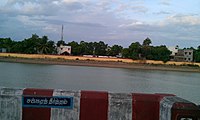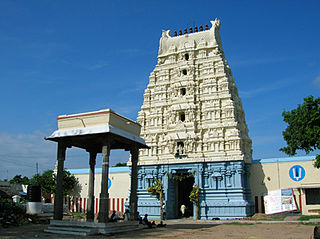
Sri Bhaktavatsala Perumal temple is a Hindu temple, located at Thirunindravur, a western suburb of Chennai, India. It is dedicated to the Hindu deity Vishnu. Constructed in the Dravidian style of architecture, the temple is glorified in the Naalayira Divya Prabandham, the early medieval Tamil canon of the Alvar saints from the 6th–9th centuries CE. It is one of the 108 Divya Desams dedicated to Vishnu, who is worshipped as Bhaktavatsala Perumal and his consort Lakshmi as Ennai Petra Thayar.

Oppiliappan Temple, is a Hindu temple dedicated to Vishnu, located near Thirunageswaram and also known by its old toponym Thiruvinnagar, a village in the outskirts of the Kumbakonam in the South Indian state of Tamil Nadu. Constructed in the Dravidian style of architecture, the temple is glorified in the Naalayira Divya Prabandham, the early medieval Tamil canon of the Alvar saints from the 6th–9th centuries CE. It is counted as the 60th of the 108 Divya Desams dedicated to Vishnu. Vishnu is worshiped as Oppiliappan and his consort Lakshmi as Bhudevi.
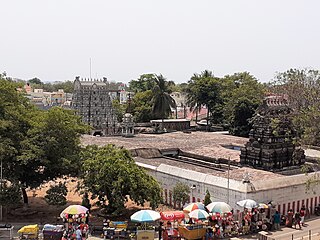
Sthalasayana Perumal Temple is at Mahabalipuram. Constructed in the Dravidian style of architecture, the temple is glorified in the Naalayira Divya Prabandham, the early medieval Tamil canon of the Alvar saints from the 6th–9th centuries CE. It is one of the 108 Divya Desam dedicated to Vishnu, who is worshipped as Sthalasayana Perumal and his consort Lakshmi as Nilamangai Thayar. The temple is believed to have been built by the Pallavas, with later contributions from the Medieval Cholas, Vijayanagara kings, and Madurai Nayaks.

The Pundarikakshan Perumal Temple or Thiruvellarai Temple in Thiruvellarai, a village in the outskirts of Tiruchirappalli in the South Indian state of Tamil Nadu, is dedicated to the Hindu god Vishnu. Constructed in the Dravidian style of architecture, the temple is glorified in the Naalayira Divya Prabandham, the early medieval Tamil canon of the Alvar saints from the 6th–9th centuries CE. It is one of the 108 Divya Desams dedicated to Vishnu, who is worshipped as Pundarikakshan and his consort Lakshmi as Pankajavalli.
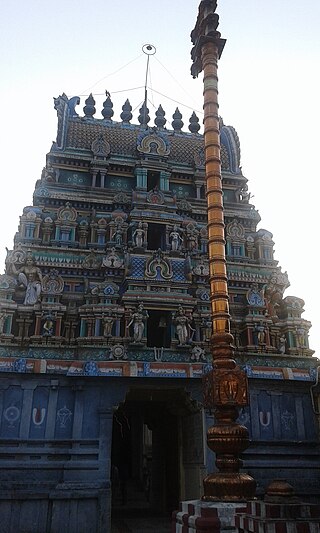
The Devaadi Raja Perumal temple in Therazhundur, a village in Mayiladuthurai district of the South Indian state of Tamil Nadu, is dedicated to the Hindu god Vishnu. Constructed in the Dravidian style of architecture, the temple is glorified in the Naalayira Divya Prabandham, the early medieval Tamil canon of the Alvar saints from the 6th–9th centuries CE. It is one of the 108 Divya Desams dedicated to Vishnu, who is worshipped as Amaruviappan, and his consort Lakshmi as Sengamalavalli Thayar. The original structure of the temple was built by the Karikala Chola during the 1st century CE, with later additions from the Cholas during the 11th century.

The Deepaprakasa Perumal Temple, also referred to as Tiruththanka, and Tooppul, is located in Kanchipuram in the South Indian state of Tamil Nadu, is a temple dedicated to the Hindu god Vishnu. Constructed in the Dravidian style of architecture, the temple is glorified in the Naalayira Divya Prabandham, the early medieval Tamil canon of the Alvar saints from the 6th–9th centuries CE. It is one of the 108 Divya Desams dedicated to Vishnu, who is worshipped as Deepaprakasar, and his consort Lakshmi as Maragathavalli.

Thiru Anbil, or Sundararaja Perumal Temple, in Anbil, a village in the outskirts of Tiruchirappalli in the South Indian state of Tamil Nadu, is dedicated to the Hindu god Vishnu. Constructed in the Dravidian style of architecture, the temple is glorified in the Naalayira Divya Prabandham, the early medieval Tamil canon of the Alvar saints from the 6th–9th centuries CE. It is one of the 108 Divya Desams dedicated to Vishnu, who is worshipped as Sundararajan and his consort Lakshmi as Sundaravalli.

Hara Saabha Vimochana Perumal Temple in Thirukandiyur, a village in the outskirts of Thiruvayaru in the South Indian state of Tamil Nadu, is dedicated to the Hindu god Vishnu. Constructed in the Dravidian style of architecture, the temple is glorified in the Nalayira Divya Prabandham, the early medieval Tamil canon of the Alvar saints from the 6th–9th centuries CE. It is one of the 108 Divya Desam dedicated to Vishnu, who is worshipped as Hara Saabha Vimochana Perumal and his consort Lakshmi as Kamalavalli Nachiyar.
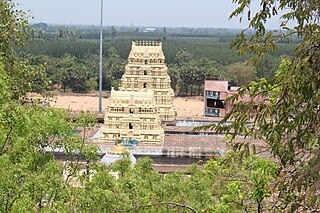
Devanatha Hemabhujavalli Temple is a Hindu temple in Thiruvanthipuram, a village in the outskirts of Cuddalore in the South Indian state of Tamil Nadu, dedicated to the god Vishnu and goddess Lakshmi. Constructed in the Dravidian style of architecture, the temple is glorified in the Nalayira Divya Prabandham, the early medieval Tamil canon of the Alvar saints from the 6th–9th centuries CE. It is one of the 108 Divya Desams dedicated to Vishnu, who is worshipped as Devanatha and Lakshmi as Hemabhujavalli. Though the presiding deity is Devanatha and Hemabhujavalli, the temple is known for Hayagriva, the ninth avatara of Vishnu in the Dashavatara of Vishnu and a god of knowledge. The temple is the only historical temple in South India to have a shrine of Hayagriva on hilltop.

Kazheesirama Vinnagaram or Tadalan Kovil or Tiruvikrama (trivikara) Perumal Temple is a temple dedicated to Vishnu located in Sirkazhi, Tamil Nadu, India. Constructed in the Dravidian style of architecture, the temple is glorified in the Nalayira Divya Prabandham, the early medieval Tamil canon of the Alvar saints from the 6th–9th centuries CE. It is one of the 108 Divya Desam dedicated to Vishnu, who is worshipped as Trivikrama and his consort Lakshmi as Loganayagi. The temple is believed to have been built by Cholas, with later contributions from Medieval Cholas, Vijayanagara kings, and Madurai Nayaks.
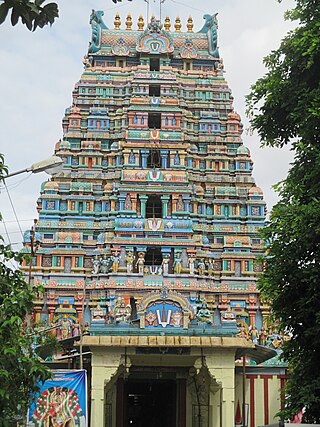
The Soundararajaperumal Temple is a temple dedicated to the Hindu god, Vishnu. It is located in Nagapattinam, a town in the South Indian state of Tamil Nadu. Constructed in Dravidian style of architecture, the temple is glorified in the Nalayira Divya Prabandham, the early medieval Tamil canon of the Alvar saints from the 6th–9th centuries CE. It is counted as one among the 108 Divya Desams dedicated to Vishnu. Vishnu is worshiped as Soundararaja Perumal and his consort Lakshmi as Soundaravalli.

Parimala Ranganathar Perumal Temples or Tiruindaloor is a Hindu temple dedicated to Vishnu, located in Thiruvilandur of Mayiladuthurai, a town in the South Indian state of Tamil Nadu. It is one of the Divya Desams, the 108 temples of Vishnu revered in Nalayira Divya Prabandham by the 12 poet saints, or the Alvars. This temple is along Kaveri and is one of the Pancharanga Kshetrams.
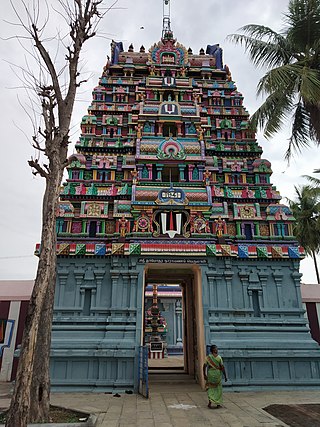
The Loganatha Perumal Temple is a Hindu temple dedicated to Vishnu located 2 km away from Sikkal, Tamil Nadu, India on the Tiruvarur-Nagapatnam highway. Constructed in the Dravidian style of architecture, the temple is glorified in the Nalayira Divya Prabandham, the early medieval Tamil canon of the Alvar saints from the 6th–9th centuries CE. It is one of the 108 Divya Desams dedicated to Vishnu, who is worshiped as Loganatha Perumal and his consort Lakshmi as Loganayagi.

The Gajendra Varadha Perumal Temple in Thirukkavithalam, a village in the outskirts of Papanasam in the South Indian state of Tamil Nadu, is dedicated to the Hindu god Vishnu. Constructed in the Dravidian style of architecture, the temple is glorified in the Nalayira Divya Prabandham, the early medieval Tamil canon of the Alvar saints from the 6th–9th centuries CE. It is one of the 108 Divya Desams dedicated to Vishnu, who is worshipped as Gajendra Varadha Perumal and his consort Lakshmi as Ramamanivalli. The temple is one of the five Pancha-Kannan temples, where Krishna, an avatar of Vishnu is given prominence over the presiding deity.
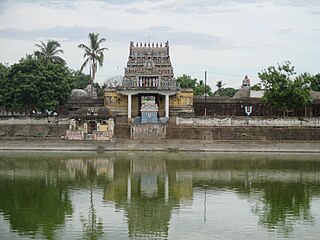
The Bhaktavatsala Perumal Temple is a temple dedicated to Hindu god Vishnu, located in Thirukannamangai, a village in Tiruvarur district in the South Indian state of Tamil Nadu. Constructed in Dravidian style of architecture, the temple is glorified in the Nalayira Divya Prabandham, the early medieval Tamil canon of the Alvar saints from the 6th–9th centuries CE. It is counted as one among the 108 Divya Desams dedicated to Vishnu. Vishnu is worshipped as Bhaktavatsala Perumal and his consort Lakshmi as Kannamangai Nayagi.

Ulagalantha Perumal Temple or Trivikrama Temple is a Hindu temple dedicated to Vishnu located in Tirukkoyilur, Tamil Nadu, India. Constructed in the Dravidian style of architecture, the temple is glorified in the Naalayira Divya Prabandham, the early medieval Tamil canon of the Alvar saints from the 6th–9th centuries CE. It is one of the 108 Divya Desams dedicated to Vishnu, who is worshipped as Ulagalantha Perumal and his consort Lakshmi as Poongothai. The temple is believed to have been built by the Medieval Cholas, with later contributions from Vijayanagara kings and Madurai Nayaks. The temple covers an area of 5 acres (20,000 m2) and has a temple tower that is the third tallest in Tamil Nadu, measuring 192 ft (59 m) in height.

Thanjai Mamani Koil is a set of three adjacent Hindu temples dedicated to Vishnu located in Thanjavur, Tamil Nadu, India. It is one of the Divya Desams, the 108 temples of Vishnu revered by the 12 poet saints called the Alvars. Unlike other Divya Desams where a single shrine is referenced, this set of temples is referred together in all the pasurams.
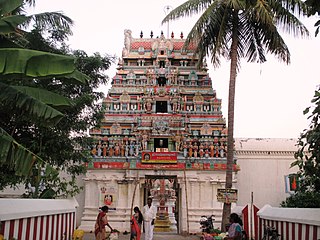
Nathan Kovil or Thiru Nandipura Vinnagaram Temple in Nathan Kovil, a village in the outskirts of Kumbakonam in the South Indian state of Tamil Nadu, is dedicated to the Hindu god Vishnu. Constructed in the Dravidian style of architecture, the temple is glorified in the Nalayira Divya Prabandham, the early medieval Tamil canon of the Alvar saints from the 6th–9th centuries CE. It is one of the 108 Divya Desams dedicated to Vishnu, who is worshipped as Jagannathan and his consort Lakshmi as Shenbagavalli.
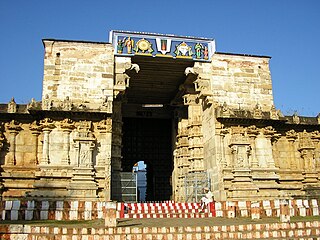
Vaishnava Nambi and Thirukurungudivalli Nachiar Temple in Thirukkurungudi, a village in Tirunelveli district in the South Indian state of Tamil Nadu, is dedicated to the Hindu god Vishnu. It is located 45 km from Tirunelveli. Constructed in the Dravidian style of architecture, the temple is glorified in the Naalayira Divya Prabandham, the early medieval Tamil canon of the Alvar saints from the 6th–9th centuries CE. It is one of the 108 Divya Desams dedicated to Vishnu, who is worshipped as Vaishnava Nambi and his consort Lakshmi as Thirukurungudivalli. The temple is locally referred as Dakshina Vaikuntam, the holy abode of Vishnu.
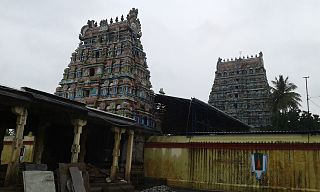
Vedarajan Temple in Thirunagari, a village in Mayiladuthurai district in the South Indian state of Tamil Nadu, is dedicated to the Hindu god Vishnu. Constructed in the Dravidian style of architecture, the temple is glorified in the Naalayira Divya Prabandham, the early medieval Tamil canon of the Alvar saints from the 6th–9th centuries CE. It is one of the 108 Divya Desams dedicated to Vishnu, who is worshipped as Vedarajan and his consort Lakshmi as Amruthavalli. The temple is believed to be the birthplace of Thirumangai Alvar, one of the twelve Alvar saints.




